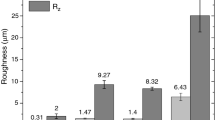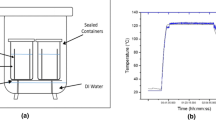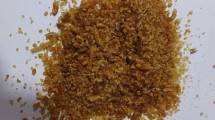Summaries
A standardised T-peel test was applied to electrolytic tinplate in order to assess the mechanical strength of coatings used on food containers. The amount of strength necessary to separate such substrates and the total energy required to detach different coatings was measured. The effect of temperature and curing time on the adhesive joints was also evaluated. The results indicated which factors must be kept in mind for the correct application of this test. Finally, this study validated the importance of the T-peel test in the quality control of containers in order to increase the service life of the tinplate/food system.
Résumé
Un essai normalisé de pliage en Ta été effectué sur fer-blanc électrolytique afin de déterminer les propriétés méchaniques nécessaires à détacher les revêtements à partir des supports et aussi l’energie nécessaire pour éffectuer un détachement total, dans le cas de divers revêtements, a été mesuré. L’effet de température et de la durée de cuison sur les joints etait egalement évalué. Les résultats ont indiqué les facteurs dont il en tenir attention à l’égard du juste conduite de ce-essaie. Enfin cette étude a confirmé l’importance de l’essaie de pliage en T dans le domaine de contrôle de qualité des emballages afin d’augmenter la vie utile de fer-blanc et des denrées alimentaires.
Zusammenfassung
Eine Methode bei T-Biegung wurde auf Weißblech um der mechanischen Stärke der Beschichtungsstoffes für Nahrungsmittelverpackungen zu bestimmen angewandt. Die Menge der Kraft nötig zu trennen solche Untergrunde und auch die gesamte Kraft nötig zu trennen die verschiedenen Beschichtungsstoffe wurden bestimmt. Die Einfluß der Temperatur und die Vernetzungzeit auf die Fugen des Klebstoffs wurden auch bewertet. Die Resultaten zeigten welche Facktoren mu man immer im Kopt halten um die richtige Anwendung der Prüfung zu bekommen. Schlie ßlich bestätigte die Bedeutung der Normungprüfungmethode bei der Quaitätskontrole der Verpackungen um die Lebensdauer des Weißblech-Nahrungsmittel-systems zu verbessern.
Similar content being viewed by others
References
Gent, AN and GR Hamed, “Peel Mechanics of Adhesive Joints,”Polymer Engineering and Science,17, 462–6, July 1977.
Catalá R, JM Cabañes and JM Bastidas, “Monitoring the Corrosion of Lacquered Tinplate Sheets using a new Electrochemical Double Cell,”Surface Coatings International,1, 37–40, 1998.
Kyung-Suk, K and K Junglhl, “Elasto-Plastic Analysis of the Peel Test for Thin Film Adhesion,”Transactions of the ASME,110, 266–73, July 1998.
Zumelzu E and C Cabezas, “Observations on the Influence of Microstructure on Electrolytic Tinplate Corrosion,”Materials Characterization,34, 143–8, March 1995.
Miura W, “Quality Control of Food Processing to strengthen Export Potential of Produce of SouthAmerican Origin”,JETRO, Japan,1, 1–20, 1994.
Zumelzu E and C Cabezas, “Correlations between Microstructure and Corrosion Performance of Electrolytic Tinplate”,Protection of Metals,32, 190–3, 1996.
Zumelzu, E and C Cabezas, “Influence of Tinplate Structure on its Electrochemical Performance in a Citric Citrate Medium,”J of Scientific and Industrial Research,55, 274–6, 1996.
Zumelzu E and C Cabezas, “Susceptibility to Corrosion of Tinplate Containers in Sugar-Containing Media,”Alimentaria,269, 3–40, 1996.
Berkovic K, M Pavic, N Cikovic and M Gacic, “Corrosion of Iron, Tin and Aluminium in Fruit Juices,”Acta Alimentaria,24, 1, 31–8, 1995.
Helwig EJ and HE Biber, “The Use of the Scanning Electron Microscope in Investigating Container Corrosion by Canned Foods and Beverages,”Food Structure,9, 195–202, 1990.
Bigwood D and A Crocombe, “Elastic Analysis and Engineering Design Formulae for Bonded Joints,”International Journal of Adhesion and Adhesives,9, 229–42, 1989.
Moidu AK, A Sinclair and J Spelt, “Analysis of the Peel Test: Prediction of Adherent Plastic Dissipation and Extraction of Fracture Energy in Metal to Metal Adhesive Joints,”Journal of Testing and Evaluation,23, 241–53, July 1995.
Fernlund G, M Papini, D McCammond and J Spelt, “Fracture Load Predictions for Adhesive Joints,”Composite Science and Technology,51, 587–600, 1994.
Author information
Authors and Affiliations
Corresponding author
Rights and permissions
About this article
Cite this article
Zumelzu, E., Gipoulou, G. A T-peel test to assess the adhesive properties of organic coatings applied to electrolytic tinplate. Surface Coatings International Part B: Coatings Transactions 85, 35–38 (2002). https://doi.org/10.1007/BF02699740
Issue Date:
DOI: https://doi.org/10.1007/BF02699740




